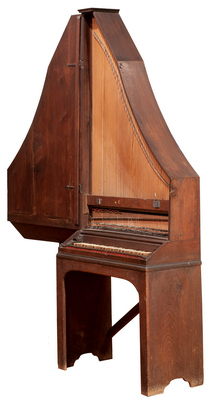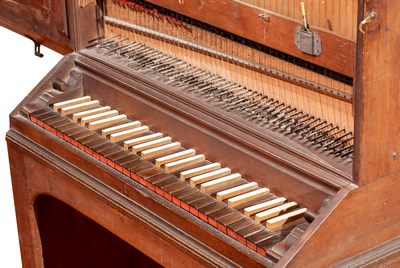Reproduction of The Moravian Historical Society's
Mid-18th-century Upright Piano
a joint project by Thomas Winter and John Watson


Project Essentials
Owner of the original piano:
Moravian Historical Society (visit website), Susan Ellis, Executive Director.
Collaborators:
The current reproduction and related research is a is a joint project by Thomas and Michele Winter of San Francisco, CA and John Watson of Williamsburg, Virginia.
Objectives:
(1) Make a thorough examination of the 18th-century original piano, producing comprehensive drawings and notes about its design and evidence of construction methods.
(2) Make a working replica of the instrument.
(3) Search the instrument and other sources for new historical information about the maker and the piano's origins and prepare a full report on our findings.
Status & Timeline
• Phase 1 (completed): Examination and documentation of the original instrument. This was completed on site in Nazareth in November, 2019
by John Watson and Tom Winter with Michele Winter.
• Phase 2 (completed): Reproduction of the piano. Work began in December 2019 and was completed by November, 2020.
About the Original Instrument
This four-octave (C-c3) upright piano is on exhibit at the Moravian Historical Society, Whitefield House, Nazareth, PA where the piano is thought to have stood almost since it was constructed in the mid-18th century. It stands 6 feet 4 inches tall, 31 inches wide and 14 inches deep. The black natural and white sharps of its keyboard reveal the German heritage of its early American builder. There are two strings per note, sounded by hammers covered on one half with a thin layer of leather, and on the other half with a slip of brass, offering to the player two different sound qualities depending on the setting of a hand stop. Only the bass third of the notes have any dampers and all of them can be turned off by means of another hand stop. A hinged door covers the front of the instrument.
For More Information
- For more about the rich musical heritage of the Moravians who settled in Pennsylvania and North Carolina in the mid-18th-century, see this Wikipedia article.
- For more information about this type of instrument, see the question and answer area below.
Thomas Marshall of the College of William and Mary Department of Music was the first to visit the shop after the reproduction became playable.
Hear the instrument's variety of voices in Sonata VIII by the American composer John Christopher Moller, possibly 1792
Photo Galleries — Project Phases
In-depth Examination and Documentation
For two weeks in November 2019, Tom and Michele Winter and John Watson conducted an on-site examination of the original piano. Tom and Michele focused primarily on the mechanical action and John focused on the remainder of the instrument. We documented physical details about the instrument in notes, photographs, and CAD drawings. Clues about the maker, his methods of work, his skill, and the web of experiences and influences that inspired his design were among the most fascinating observations to be made.
Click the photo on the left for 36 photos from the examination.
Making the Mechanical Action
The action is being made by Tom Winter in his workshop in San Francisco. Action components include the keys, keyframe, squares (that transfer motion from key to hammer), hammers, and hammer register. Tom is also making the stop action consisting of a hand stop for shifting the hammers to their loud and soft positions, and another hand stop for lifting the dampers from the strings
Click the photo on the left for 15 photos of the mechanical action construction.
Making the Case - Part 1
The casework, including the main case, internal framing, soundboard, bridge, nut, strings, front door, and stand, is being made by John Watson in Williamsburg, Virginia.
Click the photo on the left for 8 photos of the case construction.
Making the Case - Part 2
Continuing in Williamsburg, the thick inner rim veneer is added and other interior details are completed;
the soundboard now made and attached with hitchpin rail and moldings, all in preparation for stringing.
Click the photo on the left for 8 more photos of the case construction
Q & A
At the same time that the piano was being invented by Cristofori in Italy around 1700, a flamboyant German virtuoso named Pantaleon Hebenstreit was popularizing a type of large complex dulcimer that he played with a variety of hand-held hammers. His instrument had no keyboard and came to be called a pantalon. So popular were Hebenstreit’s performances that some harpsichord makers in Germany and elsewhere began making instruments with keyboards to operate the hammers so anyone with keyboard ability could imitate Hebenstreit’s performances. Since these makers were basing their instruments on Hebenstreit’s pantalon and not on Cristofori’s piano, some period references and a few scholars today call such an instrument a “keyboard pantalon” or just a pantalon. Michael Cole’s web page Pianoforte & Pantalon explains his logic for calling the Nazareth upright a pantalon.
Those early keyboard instruments designed to imitate the pantalon, of which the Nazareth instrument is an example, were distinguishable for having several characteristics that differed from Cristofori’s piano: (1) bare wood hammers or thinly leathered wood hammers, (2) lack of dampers or dampers that could be left off, and (3) one or more stops to soften the sound, such as cloth or soft leather inserted between hammers and strings in imitation of the gut strings of Hebenstreit’s pantalon. But there is a problem with calling instruments with those characteristics pantalons and not pianos. As those effects gained popularity, most of the pianos made in the 18th century incorporated one or more of those characteristics. That leads to an imponderable question: when does a "keyboard pantalon" stop being a pantalon and become a piano? The best solution, we think, is to define piano as any stringed keyboard instrument with hammers that strike the strings. Then we can hasten to add how much the design of any particular piano is influenced by Hebenstreit’s pantalon performances. In the case of the Nazareth piano, there is much more influence from Hedbenstreit than from Cristofori’s original concept of a piano, so we'll call it piano with strong pantalon characteristics.
For a clear analysis of 18th-century piano history in terms of the commingling of Cristofori’s invention of the piano with varying amounts of influence from Hebenstreit’s pantalon performances, see Michael Latcham’s book, Towards a new history of the piano published by Musikverlag Katzbichler in 2019.
Considered the first professional organ builder in colonial America, Clemm continued building organs and other types of keyboard instruments throughout his life. He is best known for training the most celebrated early American organ builder, David Tannenberg. Clemm lived with the Tannenbergs in the latter part of his life, including two years (1759-60) at Nazareth's Whitefield house, where the upright piano is thought to have spent its entire history.
Attribution to Clemm is based on several circumstances which, taken together, are compelling:
- The use of North American woods (Atlantic white cedar and yellow poplar) in the casework indicate the instrument was made on this side of the Atlantic and not imported from the Old Country.
- The combination of black walnut with white cedar in the instrument is linked to Clemm through at least two other instruments: his only surviving instrument, a 1739 spinet at the Metropolitan Museum of Art is walnut with a white cedar soundboard, and Clemm's original specifications for an organ he was to build for Trinity Church in New York specified those two woods for the windchest.
- Assuming a construction date between 1745 and 1765 (about which there is more evidence below), the list of skilled instrument makers operating in America is very short, with Clemm being the one most likely skilled and experienced enough to make such an instrument.
- The straightforward and sophisticated design of the casework and its mechanical action, along with the lack of naïve mistakes often present in less informed and experimental work indicates a maker with a great deal of experience making keyboard instruments. This is a type of evidence that only becomes clear during the process of making an accurate reproduction.
- The instrument hints at the maker’s orientation to organ design in the use of a trundle in the stop action.
- The unusual scaling of the string lengths suggests an organ builder’s bias and a construction date prior to 1765: The piano’s scaling scheme was used for organ pipes (not piano or harpsichord strings) from the middle of the 17th century until it was replaced with an approach based on logarithms. Pennsylvania organ builders adopted the logarithmic scheme in 1765 when its inventor, German theorist Georg Andreas Sorge, sent his treatise to Clemm and Tannenberg. For more about the scale evidence, write to us.
In the larger history of the piano, however, this example is not entirely unique. Back in Saxony in the 1730s, as Clemm and the group of Moravians were leaving Germany for America, pantalon-inspired keyboard instruments of various upright, rectangular, and harpsichord-like shapes were beginning to appear.




